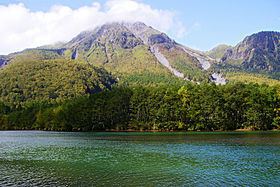Age of rock 20,000 years Elevation 2,455 m | Last eruption 1995 Easiest route Hiking | |
 | ||
Similar Mount Hotakadake, Mount Yari, Mount Norikura, Nishihotakadake, Mount Kasa | ||
Top of mount yake dake
Mount Yake (焼岳, Yake-dake) literally, "Burning mountain" is an active volcano in the Hida Mountains, lying between Matsumoto, Nagano Prefecture, and Takayama, Gifu Prefecture, Japan. It is one of the 100 Famous Japanese Mountains, reaching 2,455 m (8,054 ft) at the highest peak.
Contents
- Top of mount yake dake
- Map of Mount Yake Azumi Matsumoto Nagano Prefecture 390 1520 Japan
- Mount yakedake in the japanese alps
- Geography
- Eruptions
- References
Map of Mount Yake, Azumi, Matsumoto, Nagano Prefecture 390-1520, Japan
Mount yakedake in the japanese alps
Geography
Mount Yake is the most active of all the volcanoes in the Hida Mountains. Its two main peaks are the northern and southern peaks, but visitors can only ascend to the northern peak, as the southern peak is currently a restricted area. A crater lake lies between the two peaks.
Because the lava flowing from Mount Yake has a high viscosity, it is easily able to build a lava dome.
The heat from the volcano produces many onsen in the surrounding area.
Eruptions
In 1911, 22 minor eruptions were recorded. In 1915, during the Taishō period, however, there was a major eruption. The flow of the lava blocked the Azusa River, which caused the river to form a lake that was named Lake Taishō. The Azusa River is again flowing today, but the lake still remains.
In 1962, there was an eruption that killed two people staying at a small hut near the mouth of the volcano.
In 1995, a tunnel was being constructed on the Nagano Prefecture side of the mountain, through Mount Akandana, which was thought to be part of Mount Yake. At 2:25pm on February 11, the workers encountered volcanic gases, which were quickly followed by a phreatic eruption on Mount Yake, leading to the death of four people. Later explorations have shown that Mount Akandana is an independent volcano.
There is still an active fumarole near the mountain's peak.
